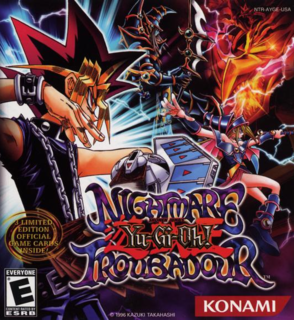Maybe there are subliminal messages in the graphics or something...why am I hooked on this game?????
I have never watched the cartoon from which all this was spawned. I have never collected the cards. I have no interest in ever doing so. As such, I can rate this game purely on its game merits, rather than as some supplicating fanboy who reflexively loves any paraphenalia with Mai Valentine's visage plastered on it. Right. On with the review.
Yu Gi come, and Yu Gi (g)Oh. The card game that nobody every really played in real life spawned what can only be called a sprawling franchise of video games spanning nearly every platform over the years. People who have never played it, or never took the time to figure out how to play it, see the spikey yellow hair and overly round eyes and think "only freaks must like this stuff".
For those of us who did spend the hours learning the intricate rules and features inherent in the game, however, Yu Gi Oh stands for games that have true depth. Chess with cards. A thinking person's game.
In other words, this franchise has stood its ground with respect to the ever-increasing tide of easy-to-play mindless pap gracing most platforms these days. It is as though developers have figured we're all too lazy or stupid to figure out a game with any depth, so they've stopped making them. Luckily, Konami hasn't completely caved to this trend, and thus we have Nightmare Troubadour.
If you have ever played a Yu Gi Oh video game, you will feel at home here. Standard rules, standard cards (with many that were missing from previous incarnations of the game), typical battle system. Read GS's review for a description of the game itself. I plan on focussing on the good and the bad.
First off, the touch-screen. FINALLY, we have a game that implements the touch screen properly. A prime example of this: You can drag and drop cards from your trunk to your deck and vice-versa. I don't know what the GS reviewers are talking about, I thought the deck management system was incredibly easy and intuitive. You don't want a card in your deck? You drag it into the trunk. Easy peasy.
In battles, the touch screen works equally well, offering a seamless interaction with the cards. Here, you double-click on a card to attack with it, touch cards to switch between attack and defend stance, etc.
The main table is depicted on the touch screen, leaving the other screen to show the card images come to life, standing up in 3d from where they are on the table, sort of like fancy chess pieces (there's that chess reference again). Some of them are pretty boxy and pixelated, but it is a nice touch, albeit a time-waster as you watch attack after attack.
The sound is pleasant, although the music can get repetitive after a few hours. One sound worth the price of admission is the 'battle' step sound...some eerie metallic echoing wail that is still cool after the thousandth time of hearing it.
The "wandering an avatar through town to find duels" has been replaced with a quicker method of using the stylus to move a homing target around a map until it turns...pink....at which time you can find a duel. I sort of miss the old way of doing things, but that's just the explorer RPG fan in me talking. I guess Konami didn't want to take away from the main reason people buy these games: to duel. As such, some will like this now-faster way of getting to duels, but others (like me) will feel a bit disconnected from the world in which you are apparently living.
The duels themselves range from simple to quite challenging, and even an experienced dueler can find themselves outmatched if they haven't sufficiently streamlined their deck. Any fan of these games expects this sort of thing, however, so no surprises here.
The game offers many many hours of dueling, no two of which are alike; the same opponent who you trounced a minute ago can come back and smoke you in five moves. The act of buying packs and honing your deck into a lean mean fighting machine can absorb hours of your time, especially if, like me, you experiment with different card sets and strategies.
It is here, I suppose, that this game separates the men from the boys (or the women from the girls): this game has a significant learning curve, as well as more depth than your average Mario and Luigi joint. Most game players will be put off by the amount of work they need to do in order to just figure out how to play, and how to manage the deck. What gamers forget, however, is the first rule of gaming: the complex games are the toughest to learn, but offer the most depth and fun if you take the time with them.
Of course, this franchise has a somewhat negative reputation among gamers who have never tried it, and nothing I say will change someone's bigoted viewpoint.
Oh well, it's their loss.

